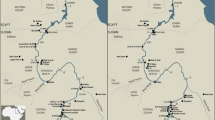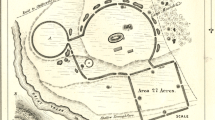Abstract
In the southeastern United States, many Native American societies invested iconographic meaning in the surface decorations incised or stamped on pottery. While some symbols represented cosmological concepts, others probably designated tribe, village, clan, or other social units. This is certainly true of groups that lived in La Florida, where, at contact, there were clear correlations between some Native American groups and pottery types. During the mission period, however, these associations became blurred. Variability diminished, and three pottery types dominated assemblages of utilitarian wares used by Native Americans and Spaniards. Heretofore, this stylistic turn of events was explained as the result of new allegiances and identities that emerged in the 1600s. It is argued here that, in the Southeast (as elsewhere), the market was responsible for some of this uniformity. Cosmological concepts present in the prehistoric variant of one of these types were retained for some time, however.
Similar content being viewed by others
References
Anderson, David G. 1998 Swift Creek in a Regional Perspective. In A World Engraved: Archaeology of the Swift Creek Culture, Mark Williams and Daniel T. Elliot, editors, pp. 274–300. University of Alabama Press, Tuscaloosa.
Ashley, Keith H., and Vicki Rolland 1997 Grog-Tempered Pottery in the Mocama Province. Florida Anthropologist 50(2):51–66.
Augusté, N. N. 2009 By Her Hands: Catawba Women and Survival: Civil War through Reconstruction. Native South 2:148–162.
Binford, Lewis R., and Nancy M. Stone 1985 “Righteous Rocks” and Richard Gould: Some Observations on Misguided “Debate.” American Antiquity 50(1):151–153.
Blumer, Thomas John 2004 Catawba Indian Pottery: The Survival of a Folk Tradition. University of Alabama Press, Tuscaloosa.
Broyles, Bettye 1968 Reconstructed Designs from Swift Creek Complicated Stamped Sherds. Southeastern Archaeological Conference Bulletin 8:49–73.
Bushnell, Amy Turner 1986 Santa Maria in the Written Record. Florida Museum of Natural History, Department of Anthropology, Miscellaneous Project Report Series, No. 21. Gainesville.
1994 Situado and Sabana: Spain’s Support System for the Presidio and Mission Provinces of Florida. Anthropological Papers of the American Museum of Natural History, No. 74. New York, NY.
Caldwell, Joseph R., and Catherine McCann 1941 Irene Mound Site, Chatham County, Georgia. University of Georgia Press, Athens.
David, Nicholas, Judy Sterner, and Kodzo Gavua 1988 Why Pots are Decorated. Current Anthropology 29(3):365–390.
Davidson, Thomas E. 2004 The Colonoware Question and the Indian Bowl Trade in Colonial Somerset County, Maryland. In Indian and European Contact in Context: The Mid-Atlantic Region, Dennis B. Blanton and Julia A. King, editors, pp. 244–364. University Press of Florida, Gainesville.
Deagan, Kathleen A. 1990 Accomodation and Resistance: The Process and Impact of Spanish Colonization in the Southeast. In Columbian Consequences: Archaeological and Historical Perspectives on the Spanish Borderlands East, David Hurst Thomas, editor, pp. 297–314. Smithsonian Institution Press, Washington, DC.
2009 Native American Ceramics at the Fountain of Youth Park Site, St. Augustine (8-SJ-31). In From Santa Elena to St. Augustine: Indigenous Ceramic Variability, Kathleen A. Deagan and David Hurst Thomas, editors, pp. 141–164. Anthropological Papers of the American Museum of Natural History, No. 90. New York, NY.
DePratter, Chester B. 2009 Irene and Altamaha Ceramics from the Charlesfort/Santa Elena Site, Parris Island, South Carolina. In From Santa Elena to St. Augustine: Indigenous Ceramic Variability, Kathleen A. Deagan and David Hurst Thomas, editors, pp. 19–48. Anthropological Papers of the American Museum of Natural History, No. 90. New York, NY.
Hally, David 2006 The Nature of Mississippian Regional Systems. In Light on the Path: The Anthropology and History of the Southeastern Indians, Thomas H. Pluckhahn and Robbie Ethridge, editors, pp. 26–42. University of Alabama Press, Tuscaloosa.
Hann, John H. (translator) 1986 General Visitation of the Provinces of Guale and Mocama made by the Capt. Don Juan de Pueyo by Title and Nomination of the Sr. Don Laureano de Torres y Ayala Knight of the Order of Santiago, Governor and Capt. General of the City, Presidio, and Prov.s of St. Augn of Florida for his Maj.y. Manuscript, Bureau of Archaeological Research, Tallahassee, FL.
Hodder, Ian 1981 Pottery, Production and Use: A Theoretical Discussion. In Production and Distribution: A Ceramic Viewpoint, H. Howard and E. Morris, editors, pp. 215–220. BAR International Series 120. Oxford, UK.
Johnson, Eric S. 2000 The Politics of Pottery: Material Culture and Political Process among Algonquians of Seventeenth-Century Southern New England. In Interpretations of Native North American Life: Material Contributions to Ethnohistory, Michael S. Nassaney and Eric S. Johnson, editors, pp. 118–145. University Press of Florida, Gainesville.
Kellar, James, H., A. R. Kelly, and Edward V. McMichael 1962 The Mandeville Site in Southwest Georgia. American Antiquity 27(3):336–355.
Laudonnière, René 1975 Three Voyages, Charles E. Bennet, translator and introduction. University of Florida Press, Gainesville.
May, J. Alan 2008 The Archaeology of Fallen Tree (9Li8). In Native American Landscapes of St. Catherines Island, Georgia II. The Data, David Hurst Thomas, editor, pp. 727–777. American Museum of Natural History, Anthropological Papers, No. 88. New York, NY.
McMurray, Judith A. 1973 The Definition of the Ceramic Complex at San Juan del Puerto. Doctoral dissertation, Department of Anthropology, University of Florida, Gainesville. University Microfilms International, Ann Arbor, MI.
Rice, Prudence M. 1987 Pottery Analysis: A Sourcebook. University of Chicago Press, Chicago, IL.
Rouse, Irving 1951 A Survey of Indian River Archeology, Florida. Yale University Press, New Haven, CT.
Sackett, James R. 1985 Style and Ethnicity in the Kalahari: A Reply to Wiessner. American Antiquity 50(1):154–159.
Saunders, Rebecca 1988 Excavations at 8NA41: Two Mission Period Sites on Amelia Island, Florida. Florida Museum of Natural History, Department of Anthropology, Miscellaneous Project Report Series, No. 35. Gainesville.
2000a Stability and Change in Guale Indian Pottery: A.D. 1300–1702. University of Alabama Press, Tuscaloosa.
2000b Pottery and Ethnicity: Yamassee Ceramics in Florida during the Mission Period. Paper presented at the 57th Southeastern Archaeological Conference, Macon, GA.
2001 Negotiated Tradition? Native American Pottery in the Mission Period in La Florida. In The Archaeology of Traditions: Agency and History Before and After Columbus, Timothy R. Pauketat, editor, pp. 77–93. University Press of Florida, Gainesville.
2009 Stability and Ubiquity: Irene, Altamaha, and San Marcos Pottery in Time and Space. In From Santa Elena to St. Augustine: Indigenous Ceramic Variability, Kathleen A. Deagan and David Hurst Thomas, editors, pp. 83–112. Anthropological Papers of the American Museum of Natural History, No. 90. New York, NY.
Saunders, Rebecca, and James B. Stoltman 1999 A Multidimensional Consideration of Complicated Stamped Ceramic Production in Southern Louisiana. Southeastern Archaeology 18(1):1–23.
Silver, Peter 2008 Our Savage Neighbors: How Indian War Transformed Early America. W. W. Norton and Company, New York, NY.
Smith, Marvin T. 1987 Archaeology of Aboriginal Culture Change in the Interior Southeast: Depopulation during the Early Historic Period. University of Florida Press, Gainesville.
Snow, David H. 1984 Spanish American Pottery Manufacture in New Mexico: A Critical Review. Ethnohistory 31(2):93–113.
Snow, Frankie, and Keith Stephenson 1998 Swift Creek Designs: A Tool for Monitoring Interaction. In A World Engraved: Archaeology of the Swift Creek Culture, Mark Williams and Daniel T. Elliot, editors, pp. 99–111. University of Alabama Press, Tuscaloosa.
Speck, Frank G. 1909 Ethnology of the Yuchi Indians. University of Pennsylvania, Anthropological Publications of the University Museum, Vol. 1, No. 1. Philadelphia.
Stoltman, James B., and Frankie Snow 1998 Cultural Interaction within Swift Creek Society: People, Pots, and Paddles. In A World Engraved: Archaeology of the Swift Creek Culture, Mark Williams and Daniel T. Elliot, editors, pp. 130–153. University of Alabama Press, Tuscaloosa.
Tanner, Helen Hornbeck 2006 The Land and Water Communication Systems of the southeastern Indians. In Powhatan’s Mantle: Indians in the Colonial Southeast, revised and expanded edition, Gregory A. Waselkov, Peter H. Wood, and Tom Hatley, editors, pp. 27–42. University of Nebraska Press, Lincoln.
Thomas, David Hurst 2008 Radiocarbon Dating on St. Catherines Island. In Native American Landscapes of St. Catherines Island, Georgia II. The Data, David Hurst Thomas, editor, pp. 345–371. Papers, No. 88. New York, NY.
2009 Late Aboriginal Ceramics from St. Catherines Island (ca. A.D. 1400–1700). In From Santa Elena to St. Augustine: Indigenous Ceramic Variability, Kathleen A. Deagan and David Hurst Thomas, editors, pp. 49–82. Anthropological Papers of the American Museum of Natural History, No. 90. New York, NY.
VanPool, Christine S., and Todd L. VanPool 1999 The Scientific Nature of Postprocessualism. American Antiquity 64(1):33–55.
Voss, Barbara 2008 Gender, Race, and Labor in the Archaeology of the Spanish Colonial Americas. Current Anthropology 49(5):861–894.
Waters, Gifford J. 2009 Aboriginal Ceramics at Three 18th-Century Mission Sites in St. Augustine, Florida. In From Santa Elena to St. Augustine: Indigenous Ceramic Variability, Kathleen A. Deagan and David Hurst Thomas, editors, pp. 165–176. Anthropological Papers of the American Museum of Natural History, No. 90. New York, NY.
Weisman, Brent R. 1992 Excavations on the Franciscan Frontier: Archaeology at the Fig Spring Mission. University Press of Florida, Gainesville.
Weissner, Polly 1985 Style or Isochrestic Variation? A Reply to Sackett. American Antiquity 50(1):160–165.
Willoughby, Charles C. 1897 An Analysis of the Decoration upon Pottery from the Mississippi Valley. Journal of American Folklore 36(10):9–20.
Wobst, H. Martin 1977 Stylistic Behavior and Information Exchange. In Papers for the Director: Research Papers in Honor of James B. Griffin, Charles E. Cleland, editor, pp. 317–342. University of Michigan Museum of Anthropology Anthropological Papers, No. 61. Ann Arbor.
Worth, John E. 1992 Appendix D. Revised Aboriginal Ceramic Typology for the Timucuan Mission Province. In Excavations on the Franciscan Frontier: Archaeology at the Fig Springs Mission, Brent R. Weisman, editor, pp. 188–205. University Press of Florida, Gainesville.
1995 The Struggle for the Georgia Coast: An Eighteenth-Century Spanish Retrospective on Guale and Mocama. Anthropological Papers of the American Museum of Natural History, No. 75. New York, NY.
1997 Integrating Ethnohistory and Archaeology among the Timucua: An Overview of Southeast Georgia and Northeast Florida. Paper presented at the 54th Southeastern Archaeological Conference, Baton
Rouge, LA. 1998 Timucuan Chiefdoms of Spanish Florida, Vol. 1. University Press of Florida, Gainesville.
2009a Ethnicity and Ceramics on the Southeastern Atlantic Coast: An Ethnohistorical Analysis. In From Santa Elena to St. Augustine: Indigenous Ceramic Variability, Kathleen A. Deagan and David Hurst Thomas, editors, pp. 141–208. Anthropological Papers of the American Museum of Natural History, No. 90. New York, NY.
2009b Explaining Native American Ceramic Variability in the Early Historic Southeast. Paper presented at the 42nd Conference on Historical and Underwater Archaeology, Toronto, ON.
Author information
Authors and Affiliations
Rights and permissions
About this article
Cite this article
Saunders, R. Deep Surfaces: Pottery Decoration and Identity in the Mission Period. Hist Arch 46, 94–107 (2012). https://doi.org/10.1007/BF03376862
Published:
Issue Date:
DOI: https://doi.org/10.1007/BF03376862




